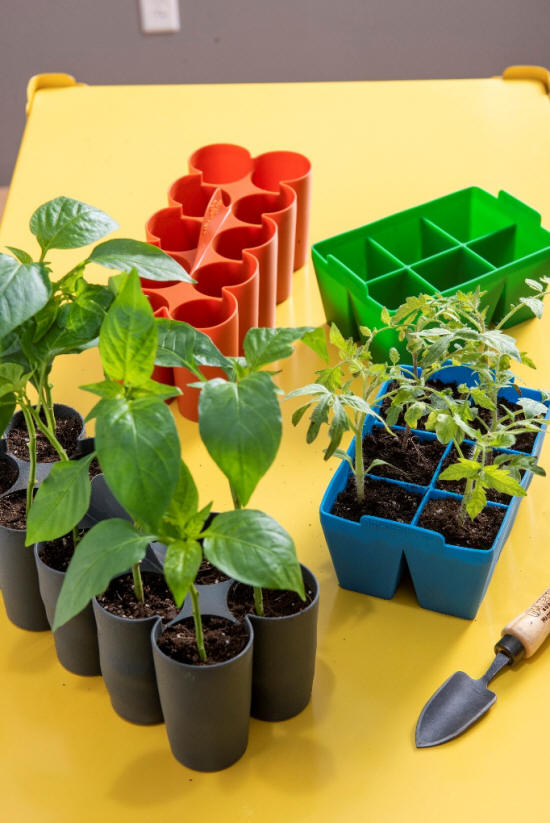|
 Save
Money and Boost Seed Starting Success Save
Money and Boost Seed Starting Success
By Melinda Myers
 Send a link to a friend
Send a link to a friend
[February 24, 2022]
Boost your success, save money, and reduce
plastic waste when starting plants from seeds this year. The options
are many, so you are sure to find one that works for you.
Reuse plastic containers for starting plants from
seeds. Disinfect the pots, flats, and cell packs before planting to
avoid problems with damping off and other diseases.
|
|
 Soak the containers in a solution of one part
bleach to nine parts water for ten minutes. Rinse with clear water.
The pots are now clean and safe for starting seeds. Soak the containers in a solution of one part
bleach to nine parts water for ten minutes. Rinse with clear water.
The pots are now clean and safe for starting seeds.
Biodegradable pots are another option. They have been around for
many years, eliminating plastic and reducing transplant shock. Just
plant the container along with the seedling when moving plants into
the garden. You will find degradable pots made from a variety of
materials.
Organic gardeners may want to use biodegradable pots made from
sustainably grown wood fiber. These contain no glue or binders and
are Organic Materials Review Institute (OMRI) listed. Cow pots are
not currently OMRI listed but are made from odor-free composted cow
manure and an alternative to plastic and peat. These are
biodegradable and add nutrients and organic matter to the soil at
planting.
Replace plastic seed starting cell packs with Honeycomb Paper pots.
This 50-cell interlocking paper seed starter expands to fill a flat
for easy planting. Roots expand through the open bottom and the
cells easily separate, making it easy to move transplants into the
garden. Once in the garden, the paper liners decompose.

Invest once and use the dishwasher-safe Sili-Seedlings Seeding Tray
for years of seed starting. These durable and reusable seed trays
are made of BPA-free food-grade silicone. The flexible cells allow
you to easily pop seedlings out without pulling and tugging. After
the transplants are removed, rinse off any remaining soil and place
in the dishwasher so the trays are ready to use for future
plantings.
Employ self-watering systems like Pop-Out Pots (gardeners.com). Move
tomatoes and other transplants from seedling trays into these larger
containers. The Pop-Out system, made from recycled polypropylene,
uses wicks to move water from the reservoir to the plants as needed.
Transplants are easily removed, and both the pots and wicks can be
reused after hand washing in hot water.
[to top of second column] |

Skip the pots and avoid transplant shock by using a
soil blocker to create an endless supply of soil blocks for
planting. Just moisten the potting mix, preferably one with a high
percent of organic matter, to help the blocks hold their shape.
Press the soil block maker into the moistened potting mix and rock
back and forth to fill. Then place the blocks on a clean seed tray.
Once planted, water from the bottom to avoid disturbing the soil
block.
Look for ways to repurpose any remaining plastic containers. Use
smaller containers to apply fertilizer, animal repellents or other
granular material. Just scoop and shake to distribute the fertilizer
over the garden bed.
Cover plants with empty pots when applying mulch to garden beds.
Spread the mulch then lift the pot when the job is finished. Use
them for double potting. Grow your plant in an old nursery pot and
set it inside a decorative pot that lacks drainage.
Some nurseries are asking customers to return plastic containers and
flats for their use. Other plant retailers have an area set aside
for customers to return plastic pots for other customers to use or
for recycling.
Sustainable gardening starts with products used for starting seeds.
Continue the trend throughout the growing season by conserving
water, repurposing leaves into mulch and recycling plant trimmings
into valuable compost.
Melinda Myers is the author of more than 20 gardening books,
including Small Space Gardening. She hosts The Great Courses “How to
Grow Anything” DVD series and the Melinda’s Garden Moment TV & radio
program. Myers is a columnist and contributing editor for Birds &
Blooms magazine and was commissioned by Gardener’s Supply for her
expertise to write this article. Her web site is
www.MelindaMyers.com.
[Photo courtesy of Gardener’s Supply
Company/gardeners.com] |